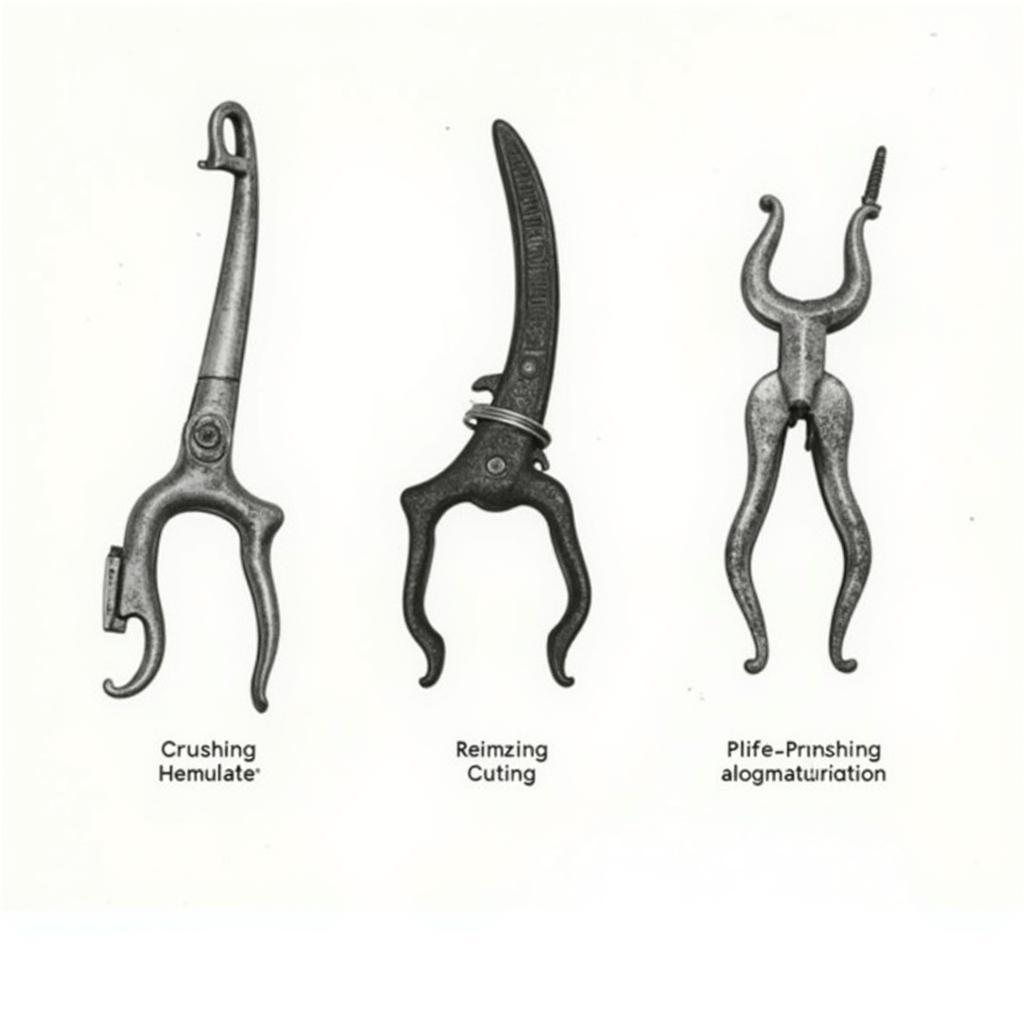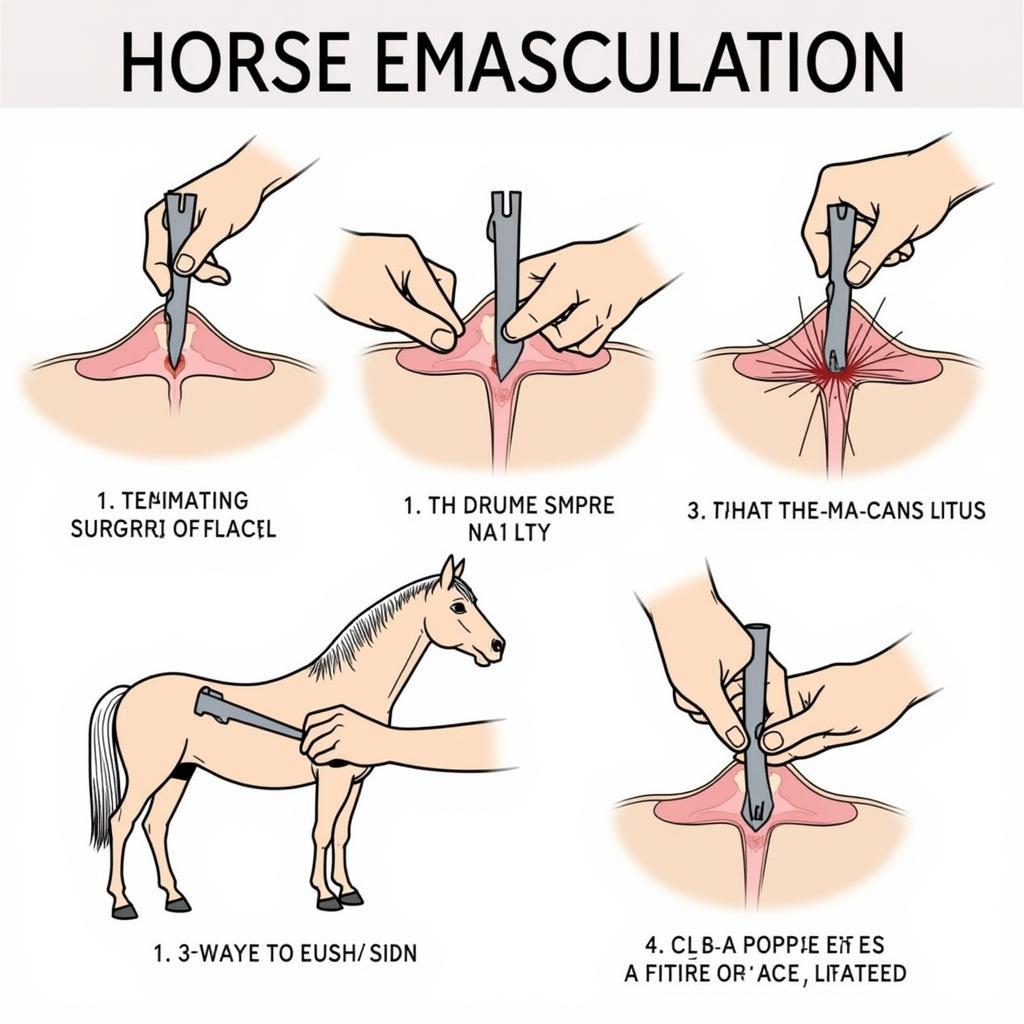A Horse Emasculator is a surgical instrument used for castration. This procedure is common practice for male horses not intended for breeding, offering numerous benefits for both the horse and the owner. This article delves into the details of horse emasculation, providing a comprehensive guide to the procedure, its benefits, and important considerations.
Why Consider Horse Emasculation?
Castration, or gelding, offers a multitude of advantages. It reduces aggressive behavior, making the horse easier to handle and train. Geldings are generally more docile and less prone to stallion-like behaviors such as fighting, mounting, and roaming. This also improves safety for handlers and other horses. Additionally, castration eliminates the risk of unwanted pregnancies, contributing to responsible horse ownership. It can also prevent certain medical conditions associated with the testicles.
Different Types of Horse Emasculators
Several types of horse emasculators are available, each designed with specific features and mechanisms. The most common types include the crushing emasculator, the Reimer emasculator, and the White emasculator. Each type varies in its crushing and cutting action, impacting the speed and effectiveness of the procedure. Understanding these differences is crucial for selecting the appropriate tool. Choosing the right emasculator depends on factors such as the horse’s age, size, and the veterinarian’s preference.
 Comparison of Crushing, Reimer, and White Horse Emasculators
Comparison of Crushing, Reimer, and White Horse Emasculators
The Emasculation Procedure: A Step-by-Step Guide
The emasculation procedure should always be performed by a qualified veterinarian. Proper anesthesia and sterile techniques are essential for minimizing pain and preventing infection. The procedure typically involves making an incision in the scrotum, exposing the testicles. The emasculator is then applied to the spermatic cord, crushing and severing it. This process is repeated for both testicles. Post-operative care is crucial for ensuring proper healing and minimizing complications.
Pre-Operative Care for Horse Emasculation
Before the procedure, the veterinarian will conduct a thorough examination of the horse to ensure it’s healthy enough for surgery. The horse will be fasted for a specific period before the procedure to reduce the risk of complications during anesthesia. The surgical site will be clipped and cleaned to maintain sterility.
Post-Operative Care for Horse Emasculation
After the procedure, the veterinarian will provide instructions on post-operative care. This includes monitoring the incision site for signs of infection, administering pain medication as needed, and ensuring the horse gets adequate rest. Regular exercise, such as walking, can help prevent swelling and promote healing.
 Step-by-step Horse Emasculation Procedure
Step-by-step Horse Emasculation Procedure
Choosing the Right Horse Emasculator: Important Considerations
Selecting the appropriate horse emasculator is crucial for a successful procedure. Factors to consider include the size and age of the horse, as well as the veterinarian’s experience and preference. Proper maintenance and sterilization of the instrument are also vital for preventing infection and ensuring its longevity.
Maintaining and Sterilizing Your Horse Emasculator
Regular maintenance and sterilization are paramount for preventing infection and extending the lifespan of your emasculator. Thoroughly clean the instrument after each use, removing any tissue or debris. Sterilize the emasculator using appropriate methods, such as autoclaving or chemical sterilization. Proper storage is also important to prevent damage and maintain sterility.
Potential Complications and How to Address Them
While generally safe, horse emasculation can have potential complications such as infection, bleeding, and swelling. Recognizing these complications early and seeking prompt veterinary attention is crucial for mitigating further issues. Proper post-operative care, as instructed by the veterinarian, can significantly reduce the risk of complications.
“Proper technique and aftercare are key to minimizing complications,” says Dr. Emily Carter, DVM, a renowned equine veterinarian with over 20 years of experience. “Following your veterinarian’s instructions diligently will greatly contribute to a smooth recovery for your horse.”
Conclusion
Horse emasculation is a common and beneficial procedure for horses not intended for breeding. Understanding the procedure, the different types of emasculators, and proper post-operative care is essential for responsible horse ownership. By choosing the right emasculator and following veterinary guidance, you can ensure a safe and successful procedure for your horse. Remember, consulting with your veterinarian is always the best approach for making informed decisions regarding your horse’s health.
FAQ
- What is the ideal age for horse emasculation?
- How long does the emasculation procedure take?
- What is the typical recovery time after horse emasculation?
- What are the signs of infection after emasculation?
- How can I minimize the risk of complications after emasculation?
- What are the different types of emasculators available?
- How much does horse emasculation typically cost?
“Early castration often leads to a more manageable temperament,” adds Dr. Carter. “It’s always best to discuss the ideal timing with your veterinarian based on your horse’s individual development.”
Other relevant articles on Justus Horses USA include articles on horse health, behavior, and general care. We also offer a comprehensive guide to horse breeding and management.
For further assistance, please contact us at Phone: 0772127271, Email: [email protected] or visit us at QGM2+WX2, Vị Trung, Vị Thuỷ, Hậu Giang, Việt Nam. We have a 24/7 customer service team ready to assist you.